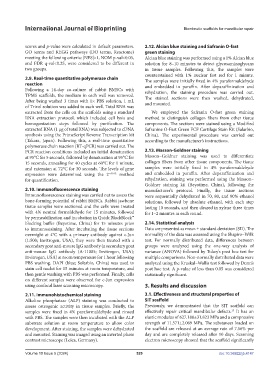Page 537 - IJB-10-5
P. 537
International Journal of Bioprinting Biomimetic scaffolds for mandibular repair
scores and p-value were calculated in default parameters. 2.12. Alcian blue staining and Safranin O-fast
GO terms and KEGG pathways (DO terms, Reactome) green staining
meeting the following criteria: |NES|>1, NOM p-val<0.05, Alcian blue staining was performed using a 1% Alcian blue
and FDR q-val<0.25, were considered to be different in solution for 8–10 minutes to detect glycosaminoglycans
two groups. in tissue samples. Following this, the samples were
counterstained with 1% nuclear fast red for 1 minute.
2.9. Real-time quantitative polymerase chain The samples were initially fixed in 4% paraformaldehyde
reaction and embedded in paraffin. After deparaffinization and
Following a 14-day co-culture of rabbit BMSCs with rehydration, the staining procedure was carried out.
TPMS scaffolds, the medium in each well was removed. The stained sections were then washed, dehydrated,
After being washed 3 times with 1× PBS solution, 1 mL and mounted.
of Trizol solution was added to each well. Total RNA was
extracted from the cells on the scaffolds using a standard We employed the Safranin O-fast green staining
RNA extraction protocol, which included cell lysis and method to distinguish collagen fibers from other tissue
homogenization steps followed by purification. The components. The sections were stained using a Modified
extracted RNA (1 µg of total RNA) was subjected to cDNA Safranine O-Fast Green FCF Cartilage Stain Kit (Salarbio,
synthesis using the PrimeScript Reverse Transcription kit China). The experimental procedure was carried out
(Takara, Japan). Following this, a real-time quantitative according to the manufacturer’s instructions.
polymerase chain reaction (RT-qPCR) was carried out. The
PCR reaction conditions included an initial denaturation 2.13. Masson-Goldner staining
at 95°C for 5 seconds, followed by denaturation at 95°C for Masson–Goldner staining was used to differentiate
15 seconds, annealing for 40 cycles at 60°C for 1 minute, collagen fibers from other tissue components. The tissue
and extension at 72°C for 30 seconds. The levels of gene samples were initially fixed in 4% paraformaldehyde
expression were determined using the 2 −ΔΔCt method and embedded in paraffin. After deparaffinization and
for quantification. rehydration, staining was performed using the Masson–
Goldner staining kit (Beyotime, China), following the
2.10. Immunofluorescence staining manufacturer’s protocol. Finally, the tissue sections
Immunofluorescence staining was carried out to assess the were sequentially dehydrated in 70, 80, and 90% ethanol
bone-forming potential of rabbit BMSCs. Rabbit jawbone solutions, followed by absolute ethanol, with each step
tissue samples were sectioned and the cells were treated lasting 10 seconds, and then cleared in xylene three times
with 4% neutral formaldehyde for 15 minutes, followed for 1–2 minutes in each round.
by permeabilization and incubation in Quick BlockBlock™
blocking buffer (Beyotime, China) for 15 minutes prior 2.14. Statistical analysis
to immunostaining. After incubating the tissue sections Data are presented as mean ± standard deviation (SD). The
overnight at 4°C with a primary antibody against c-Jun normality of the data was assessed using the Shapiro–Wilk
(1:500; Invitrogen, USA), they were then treated with a test. For normally distributed data, differences between
secondary goat anti-mouse IgG antibody (a secondary goat groups were analyzed using the one-way analysis of
anti-mouse IgG antibody (A-11005; Invitrogen, USA); variance (ANOVA) followed by Tukey’s post hoc test for
Invitrogen, USA) at room temperature for 1 hour following multiple comparisons. Non-normally distributed data were
PBS washing. DAPI (blue; Solarbio, China) was used to analyzed using the Kruskal–Wallis test followed by Dunn’s
stain cell nuclei for 15 minutes at room temperature, and post hoc test. A p-value of less than 0.05 was considered
then gentle washing with PBS was performed. Finally, cells statistically significant.
on different samples were observed for c-Jun expression
using confocal laser scanning microscopy. 3. Results and discussion
2.11. Immunohistochemical staining 3.1. Effectiveness and structural properties of
Alkaline phosphatase (ALP) staining was conducted to SIT scaffold
assess osteogenic activity in tissue samples. Briefly, the Previously, we demonstrated that the SIT scaffold can
25
samples were fixed in 4% paraformaldehyde and rinsed effectively repair critical mandibular defects. It has an
with PBS. The samples were then incubated with the ALP elastic modulus of 627.188±31.823 MPa and a compressive
substrate solution at room temperature to allow color strength of 11.571±2.069 MPa. The substances loaded on
development. After staining, the samples were dehydrated the scaffold are released at an average rate of 7.56% per
and mounted. Staining was imaged using an inverted phase day and are completely released after 10 days. Scanning
contrast microscope (Leica, Germany). electron microscopy showed that the scaffold significantly
Volume 10 Issue 5 (2024) 529 doi: 10.36922/ijb.4147

